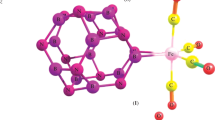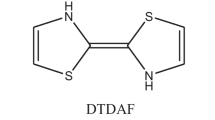Abstract
The electronic structure and chemical bonding in Re3F 2+/0/4−3 clusters are investigated using density functional theory (DFT) calculations. Out research results show that the ground state for the Re3F 2+/0/4−3 clusters is found to be triplet state 3A′1 with the D3h symmetry, quintet state 5A′ with the C s symmetry, and quintet state 5A′1 with the D3h symmetry, respectively. A detailed molecular orbital (MO) analysis reveals that the Re3F2+3 (D3h, 3A′1) dication possesses multiple (πF and partial δRe) aromaticity that is respectively responsible for the triangular F3 framework and the triangular Re3 framework in the Re3F2+3 (D3h, 3A′1) dication. The neutral Re3F3 (C s , 5A′) cluster possesses partial δ-aromaticity that is responsible for the triangular Re3 framework in the Re3F3 (C s , 5A′) cluster. The Re3F4−3 (D3h, 5A′1) anion possesses multiple (σ and partial δ) aromaticity that is responsible for the triangular Re3 framework in the Re3F4−3 (D3h, 5A′1) cluster. We also examined their hexagonal pyramidal-type Re3F3X+ (C3v, 1A′1) (X = Li, Na, K) and Re3F3Y2+ (C3v, 1A′1) (Y = Be, Mg, Ca) complexes containing the Re3F3 (D3h, 1A′1) ligand to reveal that the Re3F3 (C3h, 1A′1) structural unit is perfectly preserved in these Re3F3X+ (C3v, 1A′1) and Re3F3Y2+ (C3v, 1A′1) complexes also having the corresponding d-orbital aromatic characters.
Similar content being viewed by others
References
F. A. Cotton, N. F. Curtis, C. B. Harris, B. F. G. Johnson, S. J. Lippard, J. T. Mague, W. R. Robinson, and J. S. Wood, Science, 145, 1305–1307 (1964).
F. A. Cotton and J. T. Mague, Inorg. Chem., 3, 1402–1407 (1964).
F. A. Cotton and S. J. Lippard, Inorg. Chem., 4, 59–65 (1965).
M. J. Bennett, F. A. Cotton, and B. M. Foxman, Inorg. Chem., 7, 1563–1569 (1968).
K. Rinke and H. Schäfer, Angew. Chem., 77, 131 (1965).
H. Schäfer, K. Rinke, and H. Rabeneck, Z. Anorg. Allg. Chem., 403, 23–34 (1974).
K. Rinke, M. Klein, and H. Schäfer, J. Less–Common Met., 12, 497–503 (1967).
A. P. Sergeeva and A. I. Boldyrev, Comm. Inorg. Chem., 31, 2–12 (2010).
P. F. Week, A. P. Sergeeva, E. Kim, A. I. Boldyrev, and K. R. Czerwinski, Inorg. Chem., in press.
L. Alvarbo-Soto, R. Ramirez-Tagle, and R. Arratia-Perez, Chem. Phys. Lett., 467, 94–96 (2008).
L. Alvarbo-Soto, R. Ramirez-Tagle, and R. Arratia-Perez, J. Phys. Chem. A, 113, 1671–1673 (2009).
A. C. Tsipis, I. G. Depastas, E. E. Karagiannis, and C. A. Tsipis, J. Comput. Chem., 31, 431–446 (2010).
J. A. Moulijn and J. C. Mol, J. Mol. Catal., 46, 1–14 (1988).
J. C. Mol, Catal. Today, 51, 289–299 (1999).
W. A. Herrmann, J. G. Kuchler, J. K. Felixberger, E. Herdtweck, and W. Wagner, Angew. Chem. Int. Ed., 27, 394–396 (1988).
B. B. Averkiev and A. I. Boldyrev, J. Phys. Chem. A, 111, 12864–12866 (2007).
B. Wang, H. J. Zhai, X. Huang, and L. S. Wang, J. Phys. Chem. A, 112, 10962–10967 (2008).
H. Tanaka, S. Neukemans, E. Jansses, R. E. Silverans, and P. Lievens, J. Am. Chem. Soc., 125, 2862/2863 (2003).
T. Höltzl, E. Janssens, N. Veldeman, T. Veszprémi, P. Lievens, and M. T. Nguyen, Chem. Phys. Chem., 9, 833–838 (2008).
T. Höltzl, N. Veldeman, T. Veszprémi, P. Lievens, and M. T. Nguyen, Chem. Phys. Lett., 469, 304–307 (2009).
C. S. Wannere, C. Corminboeuf, Z. X. Wang, M. D. Wodrich, R. B. King, and P. v. R. Schlyer, J. Am. Chem. Soc., 127, 5701–5705 (2005).
W. J. Chen, H. J. Zhai, X. Huang, and L. S. Wang, Chem. Phys. Lett., 512, 49–53 (2011).
H. J. Zhai, W. J. Chen, X. Huang, and L. S. Wang, RSC. Adv., 2, 2707–2712 (2012).
X. J. Feng, T. T. Cao, L. X. Zhao, Y. M. Lei, and Y. Luo, Eur. Phys. J. D., 50, 285–288 (2008).
Y. Zubarev, B. B. Averkiev, H. J. Zhai, L. S. Wang, and A. I. Boldyrev, Phys. Chem. Chem. Phys., 10, 257–267 (2008).
M. J. Frisch, G. W. Trucks, H. B. Schlegel, G. E. Scuseria, M. A. Robb, J. R. Cheeseman, J. A. Jr. Montgomery, T. Vreven, K. N. Kudin, J. C. Burant, J. M. Millam, S. S. Iyengar, J. Tomasi, V. Barone, B. Mennucci, M. Cossi, G. Scalmani, N. Rega, G. A. Petersson, H. Nakatsuji, M. Hada, M. Ehara, K. Toyota, R. Fukuda, J. Hasegawa, M. Ishida, T. Nakajima, Y. Honda, O. Kitao, H. Nakai, M. Klene, X. Li, J. E. Knox, H. P. Hratchian, J. B. Cross, V. Bakken, C. Adamo, J. Jaramillo, R. Gomperts, R. E. Stratmann, O. Yazyev, A. J. Austin, R. Cammi, C. Pomelli, J. W. Ochterski, P. Y. Ayala, K. Morokuma, G. A. Voth, P. Salvador, J. J. Dannenberg, G. Zakrzewski, S. Dapprich, A. D. Daniels, M. C. Strain, O. Farkas, D. K. Malick, A. D. Rabuck, K. Raghavachari, J. B. Foresman, J. V. Ortiz, Q. Cui, A. G. Baboul, S. Clifford, J. Cioslowski, B. B. Stefanov, G. Liu, A. Liashenko, P. Piskorz, I. Komaromi, R. L. Martin, D. J. Fox, T. Keith, M. A. Al-Laham, C. Y. Peng, A. Nanayakkara, M. Challacombe, P. M. W. Gill, B. Johnson, W. Chen, M. W. Wong, C. Gonzalez, and J. A. Pople, Gaussian 03, P. Revision C.01 ed., Gaussian, Inc., Pittsburgh, PA (2003).
A. D. Becke, J. Chem. Phys., 98, 5648–5652 (1993).
C. Lee, W. Yang, and R. G. Parr, Phys. Rev. B, 37, 785–789 (1988).
J. P. Perdew and Y. Wang, Phys. Rev. B, 45, 13244–13249 (1992).
A. E. Reed, L. A. Curtiss, and F. Weinhold, Chem. Rev., 88, 899–926 (1988).
A. E. Reed, R. B. Weinstock, and F. Weinhold, J. Chem. Phys., 83, 735–747 (1985).
H. J. Zhai, B. B. Averkiev, D. Y. Zubarev, L. S. Wang, and A. I. Boldyrev, Angew. Chem., 119, 4355–4358 (2007).
B. Jin and Q. Jin, Comput. Theor. Chem., 1013, 130–135 (2013).
H. J. Zhai, B. B. Averkiev, D. Y. Zubarev, L. S. Wang, and A. I. Boldyrev, Angew. Chem. Int. Ed., 46, 4277–4280 (2007).
A. I. Boldyrev and L. S. Wang, Chem. Rev., 105, 3716–3757 (2005).
Author information
Authors and Affiliations
Corresponding author
Additional information
Original Russian Text © 2017 B. Jin, Q. Jin, F.-K. Jin.
Rights and permissions
About this article
Cite this article
Jin, B., Jin, Q. & Jin, F.K. Theoretical predictions on the structure and d-AO-based aromaticity of Re3F 2+/0/4−3 , Re3F3X+ (X = Li, Na, K), and Re3F3Y2+ (Y = Be, Mg, Ca) clusters. J Struct Chem 58, 1275–1285 (2017). https://doi.org/10.1134/S0022476617070034
Received:
Revised:
Published:
Issue Date:
DOI: https://doi.org/10.1134/S0022476617070034




